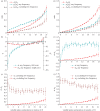Major role of positive selection in the evolution of conservative segments of Drosophila proteins
- PMID: 22673359
- PMCID: PMC3396909
- DOI: 10.1098/rspb.2012.0776
Major role of positive selection in the evolution of conservative segments of Drosophila proteins
Abstract
Slow evolution of conservative segments of coding and non-coding DNA is caused by the action of negative selection, which removes new mutations. However, the mode of selection that affects the few substitutions that do occur within such segments remains unclear. Here, we show that the fraction of allele replacements that were driven by positive selection, and the strength of this selection, is the highest within the conservative segments of Drosophila protein-coding genes. The McDonald-Kreitman test, applied to the data on variation in Drosophila melanogaster and in Drosophila simulans, indicates that within the most conservative protein segments, approximately 72 per cent (approx. 80%) of allele replacements were driven by positive selection, as opposed to only approximately 44 per cent (approx. 53%) at rapidly evolving segments. Data on multiple non-synonymous substitutions at a codon lead to the same conclusion and additionally indicate that positive selection driving allele replacements at conservative sites is the strongest, as it accelerates evolution by a factor of approximately 40, as opposed to a factor of approximately 5 at rapidly evolving sites. Thus, random drift plays only a minor role in the evolution of conservative DNA segments, and those relatively rare allele replacements that occur within such segments are mostly driven by substantial positive selection.
Figures



Similar articles
-
Hitchhiking effects of recurrent beneficial amino acid substitutions in the Drosophila melanogaster genome.Genome Res. 2007 Dec;17(12):1755-62. doi: 10.1101/gr.6691007. Epub 2007 Nov 7. Genome Res. 2007. PMID: 17989248 Free PMC article.
-
Detecting past positive selection through ongoing negative selection.Genome Biol Evol. 2011;3:1006-13. doi: 10.1093/gbe/evr086. Epub 2011 Aug 22. Genome Biol Evol. 2011. PMID: 21859804 Free PMC article.
-
The genomic rate of adaptive amino acid substitution in Drosophila.Mol Biol Evol. 2004 Jul;21(7):1350-60. doi: 10.1093/molbev/msh134. Epub 2004 Mar 24. Mol Biol Evol. 2004. PMID: 15044594
-
Mutation pressure, natural selection, and the evolution of base composition in Drosophila.Genetica. 1998;102-103(1-6):49-60. Genetica. 1998. PMID: 9720271 Review.
-
Tracking adaptive evolutionary events in genomic sequences.Genome Biol. 2002;3(6):REVIEWS1018. doi: 10.1186/gb-2002-3-6-reviews1018. Epub 2002 May 29. Genome Biol. 2002. PMID: 12093382 Free PMC article. Review.
Cited by
-
Molecular Evolution of the Bactericidal/Permeability-Increasing Protein (BPIFA1) Regulating the Innate Immune Responses in Mammals.Genes (Basel). 2022 Dec 21;14(1):15. doi: 10.3390/genes14010015. Genes (Basel). 2022. PMID: 36672756 Free PMC article.
-
Genetics of Adaptation of the Ascomycetous Fungus Podospora anserina to Submerged Cultivation.Genome Biol Evol. 2019 Oct 1;11(10):2807-2817. doi: 10.1093/gbe/evz194. Genome Biol Evol. 2019. PMID: 31529025 Free PMC article.
-
Prevalence of multinucleotide replacements in evolution of primates and Drosophila.Mol Biol Evol. 2013 Jun;30(6):1315-25. doi: 10.1093/molbev/mst036. Epub 2013 Feb 27. Mol Biol Evol. 2013. PMID: 23447710 Free PMC article.
-
Patterns of positive selection in seven ant genomes.Mol Biol Evol. 2014 Jul;31(7):1661-85. doi: 10.1093/molbev/msu141. Epub 2014 Apr 29. Mol Biol Evol. 2014. PMID: 24782441 Free PMC article.
-
Accelerated pathway evolution in mouse-like rodents involves cell cycle control.Mamm Genome. 2015 Dec;26(11-12):609-18. doi: 10.1007/s00335-015-9605-8. Epub 2015 Sep 30. Mamm Genome. 2015. PMID: 26424469
References
-
- Kimura M. 1985. The neutral theory of molecular evolution. Cambridge, UK: Cambridge University Press
-
- Yang Z., Nielsen R. 2002. Codon-substitution models for detecting molecular adaptation at individual sites along specific lineages. Mol. Biol. Evol. 19, 908–917 10.1093/oxfordjournals.molbev.a004148 (doi:10.1093/oxfordjournals.molbev.a004148) - DOI - DOI - PubMed
-
- Zhang J., Nielsen R., Yang Z. 2005. Evaluation of an improved branch-site likelihood method for detecting positive selection at the molecular level. Mol. Biol. Evol. 22, 2472–2479 10.1093/molbev/msi237 (doi:10.1093/molbev/msi237) - DOI - DOI - PubMed
-
- Studer R. A., Penel S., Duret L., Robinson-Rechavi M. 2008. Pervasive positive selection on duplicated and nonduplicated vertebrate protein coding genes. Genome Res. 18, 1393–1402 10.1101/gr.076992.108 (doi:10.1101/gr.076992.108) - DOI - DOI - PMC - PubMed
-
- Wang H.-Y., Tang H., Shen C.-K. J., Wu C.-I. 2003. Rapidly evolving genes in human. I. The glycophorins and their possible role in evading malaria parasites. Mol. Biol. Evol. 20, 1795–1804 10.1093/molbev/msg185 (doi:10.1093/molbev/msg185) - DOI - DOI - PubMed
Publication types
MeSH terms
Substances
LinkOut - more resources
Full Text Sources
Molecular Biology Databases

